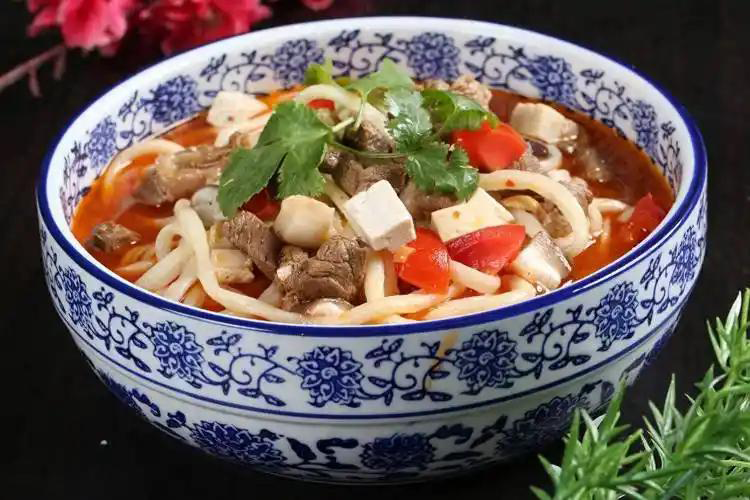A Steaming Bowl of Ningxia Flavor: Discovering Wuzhong Lamb Saozi Noodles
On the Loess Plateau of northwest China, Ningxia offers not only dramatic landscapes but also a rich culinary heritage. One must-try specialty is the steaming, aromatic dish of Wuzhong—Lamb Saozi Noodles. More than just a meal, this bowl tells the story of riverside pastures, home cooking, and local hospitality, inviting visitors to taste Ningxia’s soul.
1 Origins on the Frontier: A Bowl Shaped by History
The history of lamb saozi noodles is closely tied to Ningxia’s long farming and herding traditions. Known as “the Jiangnan beyond the frontier” for its fertile river plains, Ningxia raises abundant local Tan Sheep. Communities of Hui, Han, and other groups used fresh lamb to create a nourishing, flavorful topping called saozi—finely diced or minced meat simmered into a rich ragù. Historically served at festivals and to honored guests, saozi noodles reflect Northwest China cuisine’s generosity and culinary wisdom. In Wuzhong, this craft reached refined heights, making the dish a signature of Ningxia cuisine.
2 Cultural Meaning: Comfort, Community, and Memory
In Wuzhong, the lamb saozi noodle is more than food: it symbolizes family gatherings, life-cycle celebrations, and hometown comfort. For travelers and locals alike, a bowl brings memories of home and communal warmth. Traditional noodle houses, passed down over generations, preserve authentic flavors while neighborhood customers chat over steaming bowls—an essential slice of everyday life in Wuzhong.

3 Ingredients: The Region’s Best on the Spoon
A genuine Wuzhong lamb saozi noodle relies on top-quality ingredients:
- Soul of the dish — Ningxia Tan Sheep: The saozi’s key is lamb from local Tan Sheep raised on riverbank pastures. The meat is tender, lightly aromatic, and perfectly balanced in fat and lean—ideal for the ragù.
- Colorful accompaniments — gifts of the land: Cubed potatoes, carrots, and tofu soak up lamb juices. Potatoes add a creamy texture, carrots bring subtle sweetness, and tofu absorbs rich flavors. Optional additions include daylily, wood ear mushrooms, or tomato for color and nutrition.
- Foundation — hand-rolled noodles: Dough is kneaded, rolled into sheets, and cut into ribbons. The hand-rolled noodles are chewy and springy, pairing perfectly with the hearty saozi broth.
4 Craftsmanship: A Kitchen Symphony
Making authentic saozi noodles is both a visual and sensory performance:
- Preparing the saozi: Small cubes of Tan Sheep lamb are seared to release fragrant oils, then aromatics like scallion and ginger and spices are added. Potatoes, carrots, and tofu follow, stirred and seasoned with soy sauce and Shaoxing wine, then simmered slowly until the sauce thickens and flavors meld.
- Making the noodles: Meanwhile, chefs knead and roll dough, then cut it into even noodles. The method and rhythm guarantee ideal texture.
- Final assembly: Cooked noodles go into a bowl, topped with a generous ladle of hot lamb saozi, and finished with fresh cilantro or garlic shoots. The wheat aroma of the noodles meets the savory meat ragù for a complete sensory experience.

5 Flavor and Texture: A Feast for the Palate
The bowl arrives with an inviting appearance: reddish-brown broth, hearty toppings, and springy white noodles dotted with green herbs. The first sip reveals lamb’s natural umami—salty, mildly spicy, and richly savory without being greasy. The saozi itself is tender; vegetables are soft and sweet. The noodles remain pleasantly chewy, absorbing sauce with every bite for a layered, satisfying mouthful.
6 How to Eat It Like a Local
The authentic way is to savor both noodles and soup—“eat the noodles, then sip the broth.” After finishing the noodles, drink a few spoonfuls of soup to enjoy lingering flavors and aid digestion. Pair the bowl with local pickled vegetables or sweet-sour garlic cloves to balance richness. In many Wuzhong restaurants, noodles and saozi broth are refillable, reflecting Northwest China hospitality.

7 Traveler Tips: Where and When to Try It
- Where to eat: For the truest flavor, head to Wuzhong city, where long-established noodle houses serve classic lamb saozi noodles. Look for busy, family-run shops—often a sign of authenticity.
- Best time: While enjoyed any time, saozi noodles are especially comforting at lunch or dinner and during cool autumn and winter days.
- Ordering tips: Ask for “lamb saozi noodles” and choose portion size. If you prefer milder spice or have dietary requests, tell the cook in advance.
- Pairings: Try a cold cucumber salad or a portion of hand-shredded lamb to complete the northwest dining experience.
8 Home Version: Bring Ningxia Home
Even away from Ningxia, you can recreate a simplified saozi noodle at home:
- Simple recipe: Use diced lamb leg or shoulder, add potato, carrot, and firm tofu. Sear the meat with aromatics and spices, add vegetables and soy sauce, then simmer until thick.
- Steps: Fry lamb with ginger and scallion, add vegetables, season with light and dark soy and Shaoxing wine, add water and simmer 20–30 minutes. Cook store-bought chewy noodles and combine.
- Tips: If Tan Sheep isn’t available, add a touch of Sichuan pepperwater or toasted cumin to reduce the gamey note. A pressure cooker speeds up braising.

9 Conclusion
Wuzhong Lamb Saozi Noodles are a Ningxia culinary treasure—simple ingredients transformed by skill into a deeply satisfying dish. This bowl carries the taste of riverside pastures, the warmth of local hospitality, and generations of tradition. When visiting Ningxia, step into a small Wuzhong eatery, order a bowl of lamb saozi noodles, and let its rich warmth become a lasting memory of your journey.


